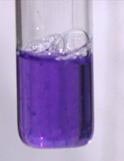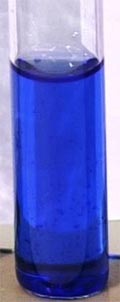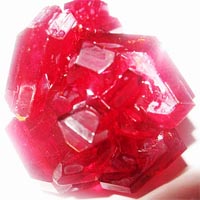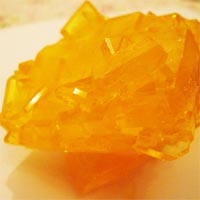Qualitative reactions - it is the reaction to determine the presence of a some substance (components) in the reaction.
Let's do 2 reaction with the protein and polyhydric alcohol
Qualitative reaction to protein

There are only 20 amino acids are building blocks for protein.
So we need a caustic soda NaOH, copper sulfate CuSO4 and protein. Dilute solution of copper sulphate and add caustic soda to. You will immediately see a precipitate. This is substantion (blue precipitate Cu(OH)2) will react with the protein. In the same flask add protein. Gradually, the solution should change color from blue to a beautiful deep purple solution. (details about protein and properties of proteins)
Qualitative reaction on polyhydric alcohol
One of the polyhydric alcohols is glycerin, and thick oily transparent liquid. It is also an integral part of the soap.

* A few about the soap: As we know, soap can be of two types: liquid (shampoo) and solid. Liquid soap is a salt of sodium (Na) of fatty acids (included of fats), hard soap is solt of potassium (K) also fatty acids. Only a small part of the large molecule of soap is under water, it part is containing sodium ion or potassium and provides the main function of washing soap. Soap in the water as an inverted iceberg. It is established that the foam, which is formed over the surface of the water - is the main part of the soap molecules ( i.e., as the underwater part of the iceberg).
Prepare a solution of copper hydroxide Cu(OH)2. For this we again need the solutions of copper sulfate and caustic soda (in place of sodium hydroxide can be used ammonia). In the resulting solution add the solution of triatomic alcohol (glycerin). It is necessary to mix the contents, because alcohol has a density less than water and will stay on the surface (of course, before adding glycerin you can get rid of the second reaction product is a transparent liquid Na2SO4 - is reaction product between sodium hydroxide and sulfate). If You did everything correctly, you will see the solution deep blue color, it is a glycerate of copper.
If was the question about the existence of a polyhydric alcohol in any of the proposed solutions, this response gives the correct answer.
Qualitative reaction for iron
For determination of iron ions (II) in solution using the red blood salt (its chemical name is potassium hexacyanoferrate - K3[Fe(CN)6]) . In this case, precipitate turbulence blue. This reaction suggests that ions of II-valent irons are present in solution.
To determine the presence of ions of iron (III) - use yellow blood salt (K4[Fe(CN)6]) or you can use potassium thiocyanate (KCSN). When using ferrocyanide (yellow blood salt) forms a blue precipitate prussian blue, and if you use the potassium thiocyanate - will see the blood-red colour of the solution due to the formation small dissociating salt.
The word "cyanide" comes from the Greek "kyanos" - azure. Yellow K4[Fe(CN)6] and red K3[Fe(CN)6] blood salts (substances of pale yellow and dark red respectively) are hexacyanoferrate salts (ferrous and relatoseroroticos) acid H4[Fe(CN)6] and H3[Fe(CN)6], isolated in solid form in the form of solvates with ether.


Red blood salt and yellow blood salt
(About iron You can read on the pagePure iron)